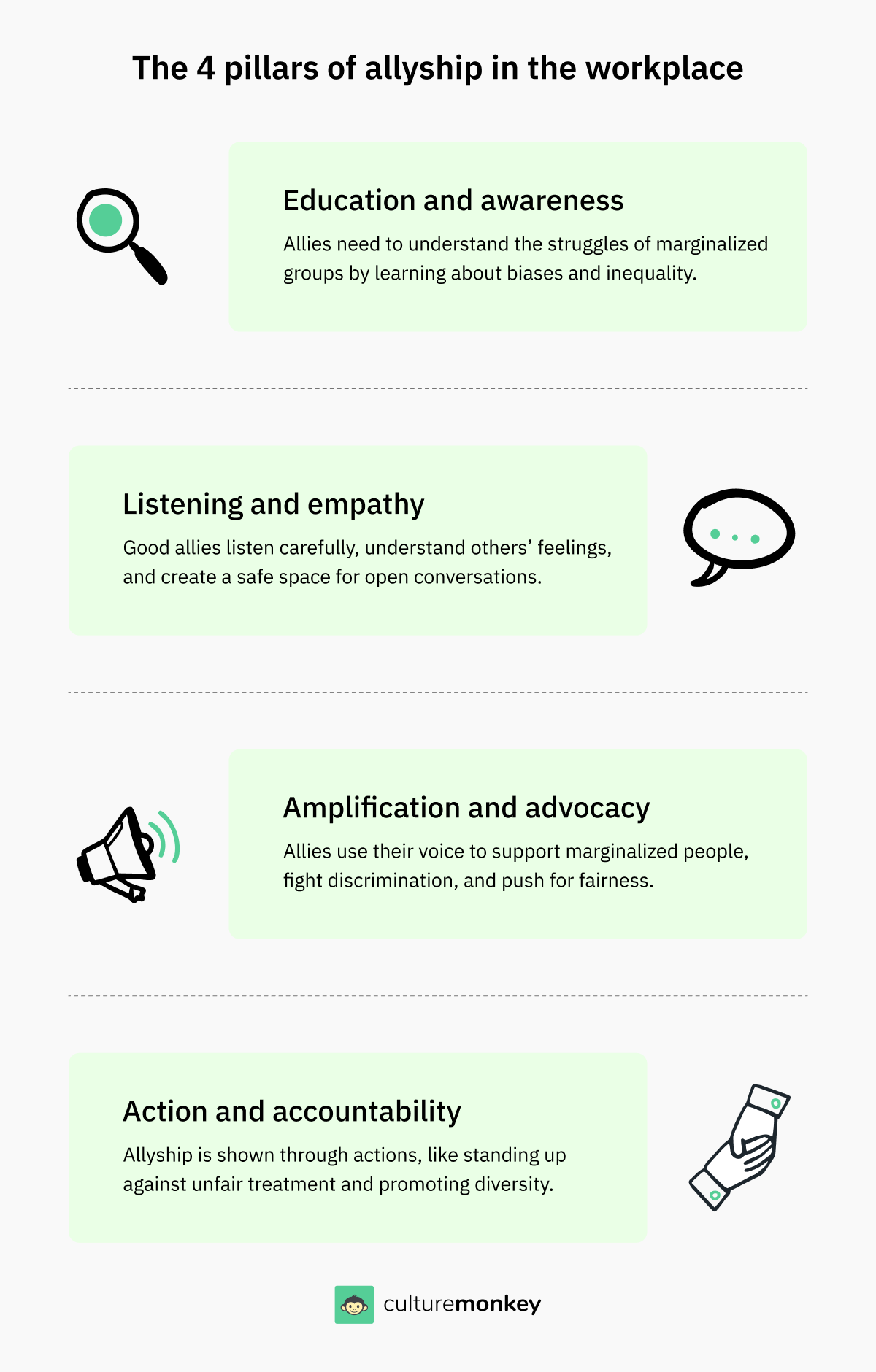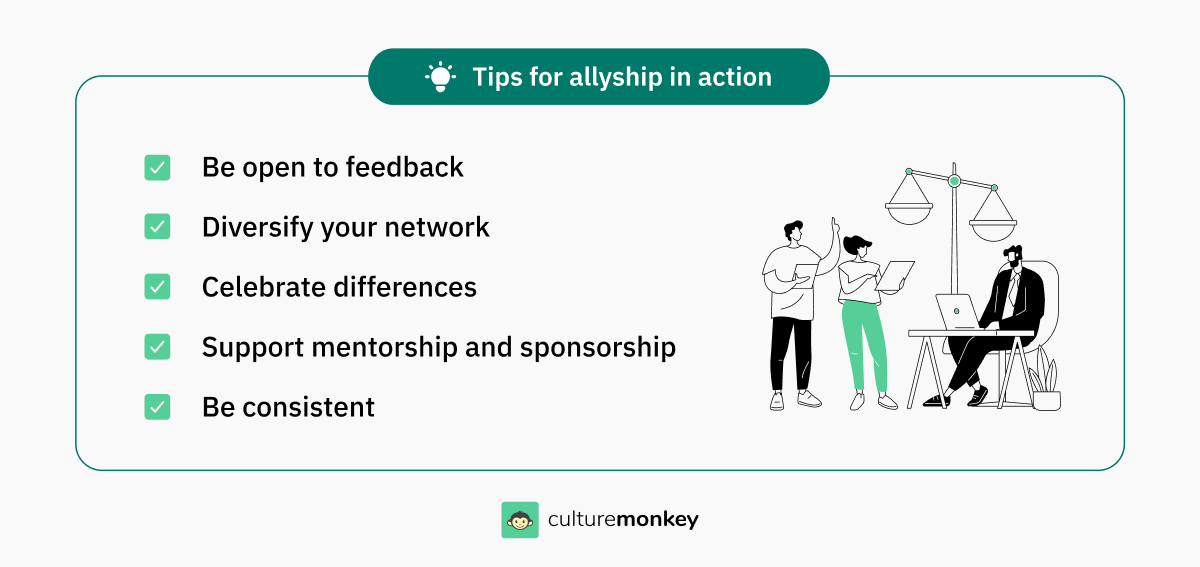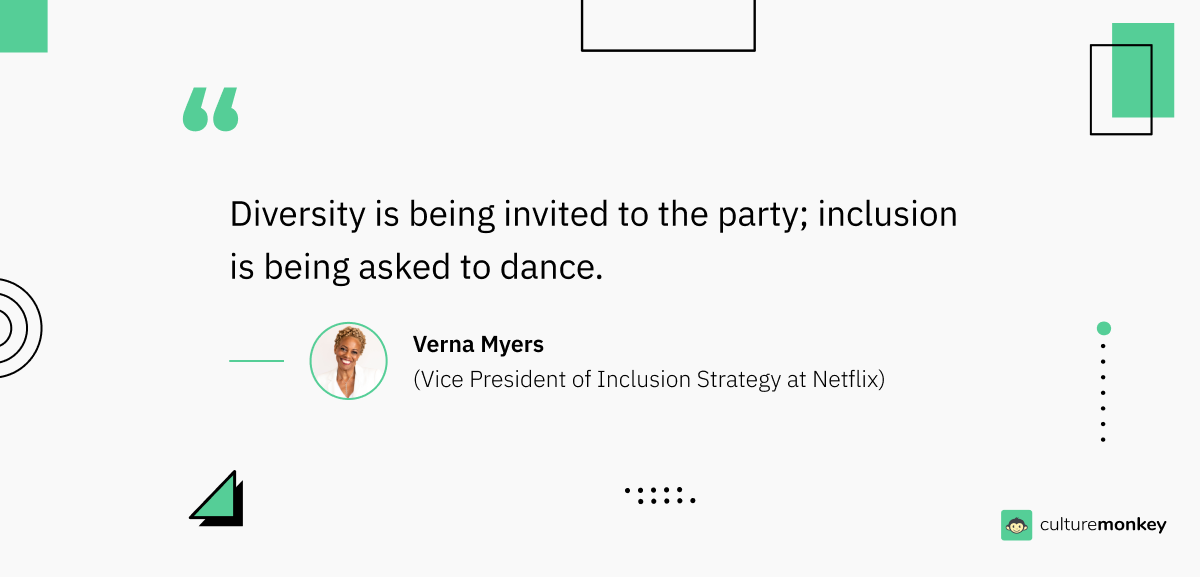Allyship in the workplace: Where inclusion meets action for impact

Imagine you’re in the midst of one of humanity’s most extraordinary achievements—the moon landing. The world watches as Neil Armstrong and Buzz Aldrin prepare to make history. Behind them stands a diverse team of engineers, mathematicians, and scientists—each with a unique role, working tirelessly at mission control.
Every piece of equipment, every decision, and every moment of communication between the astronauts and mission control is crucial. The moon landing was more than just a step for mankind; it was the culmination of meticulous teamwork, mutual trust, and support.
If even one element of collaboration had faltered, history could have taken a very different turn.
Just like in the Apollo mission, effective allyship is about recognizing the importance of every individual’s contribution. It’s about actively listening, supporting one another, and ensuring that every team member, especially those from underrepresented groups, is empowered to contribute their best work.
So, if you're serious about retaining top talent and fostering a collaborative, inclusive environment, allyship isn't optional—it's mission-critical. Let’s dive into what allyship in the workplace means and how it transforms company culture.
Blog Highlights


Allyship in the workplace definition

Allyship in the workplace means individuals actively supporting and advocating for marginalized groups. It goes beyond passive acceptance—true allies make an effort to understand the challenges faced by others, confront biases, and work to dismantle systemic barriers.
Effective allyship involves continuous learning, listening with empathy, and using one’s influence to promote inclusion, equity, and fairness. It’s not a one-time gesture but an ongoing commitment to fostering a workplace where everyone feels valued, respected, and empowered to succeed.
By educating themselves, standing up against injustice, and taking meaningful action, allies help create an environment where diversity thrives, innovation flourishes, and every voice is not only heard but celebrated, fostering stronger teams and a more inclusive culture.
The importance of allyship in the workplace
Allyship is a powerful tool for creating inclusive workplaces, but it also offers unique benefits that extend beyond diversity initiatives. Here are some unique reasons why allyship is crucial in the workplace:
- Enhances cross-departmental collaboration: Allyship encourages employees to build relationships outside of their immediate teams. By supporting colleagues from diverse departments and backgrounds, allyship fosters stronger cross-functional collaboration and teamwork.
- Boosts employee confidence: When individuals know they have allies advocating for their success, it boosts their confidence to take on new challenges, share innovative ideas, and assume leadership roles. This leads to increased employee initiative and ownership.
- Supports organizational adaptability: A culture of allyship helps organizations adapt more effectively to changing markets or external pressures. By empowering diverse perspectives, companies can pivot more quickly and develop solutions that take into account a wide range of experiences and needs.
- Improves conflict resolution: Allyship can act as a buffer during workplace conflicts, ensuring that underrepresented voices are included and heard during resolution processes. Allies help mediate conflicts by providing a balanced perspective, reducing tensions, and fostering a more harmonious work environment.
- Strengthens corporate social responsibility (CSR) initiatives: Organizations that practice allyship internally are better positioned to extend those values externally through CSR efforts. Allies help drive impactful community outreach and philanthropy initiatives, aligning internal culture with broader social goals.
- Creates leadership pipelines for diverse talent: Allyship plays a key role in nurturing future leaders from underrepresented groups by providing mentorship, guidance, and advocacy. This helps create a more diverse leadership pipeline, ensuring long-term organizational success.
Different types of allyship in the workplace

Allyship is essential for all diversity programs promoting inclusivity and equity in diverse environments. It isn't one-size-fits-all; different types of allyship address varying aspects of support for marginalized groups. Recognizing these differences allows individuals and organizations to develop more effective, tailored strategies for allyship.
Performative allyship
Performative allyship occurs when individuals or organizations publicly display support for marginalized groups without taking meaningful or sustained actions. While it may bring attention to issues, it often lacks genuine commitment effect change and can harm trust. True allies move beyond performative gestures to actively engage in change.
Intersectional allyship
Intersectional allyship recognizes that individuals face multiple, overlapping layers of marginalization, such as race, gender, sexual orientation, or disability.
Allies in this space are aware of how these identities intersect and work to address the unique challenges faced by individuals with intersecting identities, ensuring that no aspect of someone's identity is overlooked.
Transformational allyship
This type of allyship focuses on deep, systemic change within organizations. Transformational allies challenge the status quo, push for changes in organizational culture, and advocate for structural reforms that promote long-term equity and inclusion. They aim to reshape systems to be more inclusive for all employees.
Collaborative allyship
Collaborative allies work closely with marginalized groups, ensuring that their voices are at the forefront of decision-making processes. This type of allyship is rooted in partnership, mutual respect, and shared power, where allies and marginalized individuals work together toward common goals.
Educational allyship
Educational allies focus on learning and helping others learn. They actively educate themselves about the challenges faced by marginalized groups in society, and share that knowledge to raise awareness and promote understanding within their workplace.
Common myths about allyship in the workplace
There are several misconceptions about allyship that can hinder progress. Here are some common myths:
Myth 1: Allyship is only for leaders or those in power
Many believe that only individuals in leadership roles can be effective allies to marginalized group. In reality, allyship is everyone's responsibility. Anyone, regardless of their position, can offer support, advocate for the interests of others, and foster inclusivity in their workplace.
Myth 2: Allyship is a one-time action
Some assume that performing a single act of support qualifies them as an ally. However, true allyship is an ongoing commitment that requires continuous learning, reflection ongoing action, and action.
Myth 3: Allyship requires perfection
A common misconception is that allies and other leaders must have a perfect understanding of all issues before they can act. In reality, mistakes are part of the process, and the ability and willingness to learn and grow is more important than getting it right every time.
Myth 4: Allyship only benefits marginalized groups
While allyship supports underrepresented individuals and marginalized group, it benefits everyone in the organization by creating a more inclusive, equitable environment that fosters innovation, trust, and collaboration.
Myth 5: Allyship is about being vocal all the time
Some believe that the definition of being an ally means speaking out in every situation. However, allyship also involves listening, providing support privately, and recognizing when it’s more appropriate to amplify marginalized voices.
Myth 6: Allyship is divisive
Allyship is sometimes seen as a divisive force. In truth, it unites teams by promoting understanding, empathy, and inclusion, ultimately strengthening workplace dynamics and collaboration.
What are the 4 pillars of allyship?

The four pillars of allyship provide a framework for individuals to actively and authentically support marginalized or underrepresented groups in various contexts, including the workplace. These pillars are:
1. Education and awareness
Allyship begins with education and training. Individuals committed to being allies actively seek to understand the experiences, challenges, and histories of women of color and marginalized groups. This involves learning about systemic inequalities, recognizing one's own biases, and staying informed about issues affecting different communities.
2. Listening and empathy
Effective allyship requires active listening and empathetic understanding. Allies create space for open dialogue, validate the experiences of others, support colleagues, and demonstrate a willingness to learn from diverse perspectives. By fostering an empathetic environment, strong allies can build trust and strengthen connections with those they aim to support.
3. Amplification and advocacy
Allies leverage their privilege and influence to amplify the voices of marginalized individuals. This may involve advocating for inclusive policies, addressing bias and discrimination, and actively promoting opportunities for underrepresented groups.
Allies use their position to challenge systemic inequities and work towards creating a more equitable environment.
4. Action and accountability
True, allyship means it goes beyond intentions and manifests in concrete actions. Allies actively work towards creating positive change, whether by standing up against discrimination, supporting inclusive initiatives, or championing diversity in decision-making processes.
Allyship in the workplace: 6 Statistics to know in 2024

- Allyship helps significantly increase retention rates as much so that employees are 50% less likely to leave their organizations.
- Employee performance also increases in inclusive cultures jumping 56%.
- According to a survey by Glassdoor, 61% of employees in the United States believed their companies could do more to improve diversity and inclusion.
- McKinsey reported that companies in the top quartile for ethnic and cultural diversity in executive teams were 36% more likely to achieve above-average profitability.
- Research shows that in organizations where allyship and inclusion are well-rooted, employees are 56% more likely to improve their performance, and instances of employees feeling left out are reduced by 75%.
- 96% of people who work at a company where allyship is a priority, has at least one ally. It is only 56% of people in working companies are allyship is not encouraged. Strikingly, 44% of people working at the companies where allyship is not encouraged have no allies at all. While only 7% of people working in companies where the allies is a priority have no allies.
How do you build allyship at work?
Building allyship at work requires a thoughtful, ongoing effort to create a supportive and inclusive environment. It goes beyond individual gestures and calls for consistent actions that foster understanding and collaboration. Here are essential steps to build allyship in the workplace:
- Educate yourself about bias: Understanding unconscious bias is the first step. Take the initiative to educate yourself on how biases affect marginalized groups and how they manifest in everyday workplace interactions.
- Engage in active listening: Allyship requires listening without judgment or interruption. Make time to understand the perspectives of colleagues from underrepresented backgrounds, allowing their experiences to guide your actions.
- Amplify marginalized voices: Use your privilege to ensure that voices from marginalized groups are heard. In meetings and discussions, make space for underrepresented colleagues to speak, and when necessary, advocate on their behalf.
- Hold yourself and others accountable: Allyship isn’t passive. It involves calling out microaggressions and discriminatory behaviors, whether subtle or overt. Set an example by addressing these issues respectfully and constructively.
- Build relationships across differences: Make an effort to build authentic relationships with colleagues from diverse backgrounds. Genuine connections foster understanding and create a more inclusive culture.
- Support inclusive initiatives: Actively participate in diversity and inclusion initiatives at your workplace. This could involve joining employee resource groups or promoting policies that support underrepresented employees.
- Be willing to learn and evolve: Allyship is an ongoing process. Be open to feedback and continuously seek ways to improve your understanding and actions.
Advocacy vs. allyship vs. alliance
In fostering diversity, equity, and inclusion (DEI), advocacy, allyship, solidarity, and alliance are essential but distinct concepts. Understanding their differences is crucial for individuals and organizations striving to join together to create inclusive environments.
| Term | Focus | Approach | Goal |
|---|---|---|---|
| Advocacy | Broad societal reforms and systemic changes | Public campaigns, lobbying, influencing policies and social norms | Influence laws, policies, and dismantle systemic inequalities |
| Allyship | Creating supportive and inclusive immediate environments | Everyday actions, confronting bias, and promoting inclusivity | Support marginalized groups and foster inclusivity within smaller circles |
| Alliance | Formal collaborations targeting structural inequalities | Pooling resources, collaborative initiatives for policy and structural reform | Work together with shared goals to tackle broader issues |
Allyship training and resources
Allyship training and resources are essential for creating sustainable workplace inclusivity. Below are unique strategies that can elevate allyship training efforts:
- Micro-learning modules: Implement short, digestible learning modules that employees can complete in minutes. These modules can cover specific topics like addressing microaggressions or understanding privilege, making it easier for employees to absorb and apply allyship concepts regularly.
- Gamified learning experiences: Create gamified allyship training programs where employees can earn points or badges for completing tasks, quizzes, or scenarios. This approach engages participants, encouraging them to actively participate and retain what they’ve learned.
- Real-time feedback loops: Incorporate feedback mechanisms where employees can reflect on how they’ve applied their allyship training. These feedback loops allow for immediate learning adjustments and promote continuous personal growth.
- Mentorship-based allyship programs: Pair employees with experienced allies who can serve as mentors. This personalized approach gives employees practical, hands-on guidance and creates strong mentorship relationships that model effective allyship behavior.
- Cultural competency toolkits: Provide employees with toolkits containing resources like conversation starters, language guides, and cultural references. These toolkits give employees a practical set of tools to navigate complex conversations and support colleagues from diverse backgrounds more effectively.
- Allyship accountability partnerships: Encourage employees to form accountability partnerships, where they can check in with one another on their allyship efforts. These partnerships foster a sense of responsibility and ensure that allyship remains an active, ongoing practice in the workplace.
How to measure the impact of allyship in the workplace?

Measuring the impact of allyship in the workplace is crucial to determine how effectively inclusivity is being promoted. Here are key methods to assess its impact:
- Feedback from underrepresented groups: Collect direct feedback from marginalized employees to understand if they feel supported, valued, and empowered by allyship initiatives.
- Behavioral change metrics: Track how often employees intervene in bias incidents or advocate for inclusivity, indicating allyship in action.
- Promotion of inclusive leadership: Evaluate how many allies are taking on leadership roles and actively promoting inclusive policies.
- Participation in allyship programs: Monitor the engagement rates in allyship programs, workshops, and DEI training to assess overall organizational involvement.
- Workplace inclusivity audits: Conduct audits to measure the inclusivity of decision-making processes and if marginalized employees are receiving equal opportunities.
- Anonymous employee feedback platforms: Utilize platforms that allow employees to report improvements or concerns related to workplace inclusion anonymously.
- Diverse representation in teams: Assess how allyship is influencing team diversity, especially in leadership roles and decision-making positions.
- Impact on collaboration and productivity: Analyze if a stronger culture of allyship has led to improved teamwork, communication, and productivity.
Allyship in the workplace activities to try in 2024
Organizations can foster allyship workshop ideas in the workplace by implementing initiatives that promote inclusivity, encourage active participation, and create a supportive environment for all employees.
- Diversity training and workshops: Conduct regular diversity and inclusion training sessions to educate employees about various perspectives, biases, and the importance of allyship. Workshops can create a shared understanding and language around diversity issues.
- Inclusive language guidelines: Establish and promote guidelines for inclusive language usage in all communications. This helps create a workplace environment where everyone feels respected and valued.
- Intersectionality workshops: Recognize the intersecting identities of individuals by organizing workshops that focus on the unique challenges faced by those with multiple marginalized identities. This deepens understanding and promotes more nuanced allyship.
- Allyship resource groups: Create allyship resource groups or employee resource groups that focus on specific dimensions of diversity. These groups can serve as platforms for education, discussion, and collaborative initiatives.
- Feedback and accountability mechanisms: Establish feedback mechanisms to allow employees to report instances of bias or discrimination. Ensure there are clear accountability measures in place to address such issues promptly.

Allyship Survey Questions
for an Inclusive Workplace
Managers can utilize the Allyship Survey questions to gain insight into where inclusion efforts may fall short, identify areas that need attention, and evaluate how connected and supported employees feel.
- Inclusive hiring practices: Review and revise hiring processes to eliminate biases and promote diversity. Implement blind recruitment practices to avoid prioritizing any privileged group and ensure diverse interview panels to reduce unconscious bias.
9 Ways to be an ally at work as a leader
By practicing allyship, leaders create a more inclusive workplace and inspire their teams to do the same. Effective leadership in allyship promotes a culture where everyone feels valued and has the chance to thrive, generating a positive ripple effect throughout the organization.
- Incorporate diversity in leadership: Ensure that leadership positions reflect the diversity of the workforce. Representation at the top levels helps drive inclusivity throughout the organization and empowers marginalized groups.
- Conduct regular allyship training: Implement allyship-specific training programs to educate employees on how to support colleagues, recognize privilege, and effectively advocate for inclusivity.
- Measure inclusivity efforts: Use data and surveys to regularly assess the effectiveness of diversity and allyship initiatives. Track metrics related to representation, employee engagement, and feedback to identify areas for improvement.
- Reward inclusive behaviors: Recognize and reward employees who demonstrate strong allyship and contribute to fostering an inclusive workplace. This reinforces the importance of allyship in company values.
- Establish employee resource groups (ERGs): ERGs where underrepresented groups can connect, support one another, and collaborate on initiatives that enhance diversity and inclusion in the workplace.
- Diversify recruitment and hiring practices: Implement strategies to attract a more diverse pool of talent, ensuring inclusive language in job postings and removing biases in the hiring process to promote equal opportunities.
- Integrate allyship into performance reviews: Include allyship efforts as part of performance reviews, encouraging employees to actively participate in creating an inclusive environment and holding them accountable for their contributions.

How can allyship at work solve diversity & inclusion at the workplace?
Allyship as a diversity and inclusion tool in the workplace is for addressing diversity and inclusion challenges. It promotes empathy and understanding by encouraging individuals to educate themselves about their colleagues’ diverse experiences.
- Promotes active bystander behavior: Allies are encouraged to intervene when they witness discriminatory behavior or bias, helping to create a workplace where everyone feels safe and respected.
- Encourages personal accountability: Allyship promotes self-awareness and personal accountability, where individuals take responsibility for their own biases and work continuously to address them.
- Supports diverse leadership development: By advocating for diverse employees and supporting leadership pathways, allies help increase diversity in managerial and executive roles, creating more representative leadership.
- Fosters inclusive decision-making: Allies push for inclusive decision-making processes, ensuring diverse perspectives are considered in organizational strategies and day-to-day operations.
- Creates ally networks: Establishing formal or informal networks of allies can amplify collective efforts toward diversity and inclusion, creating a support system that spans departments and teams.
- Boosts employee morale: Allyship enhances overall employee morale by ensuring marginalized individuals feel seen, heard, and valued, resulting in higher levels of engagement and job satisfaction.
- Enhances retention of diverse talent: A workplace where allyship is practiced creates a more inclusive environment, leading to improved retention of diverse talent, as employees are more likely to stay where they feel supported and included.
Role of DEI surveys at work to improve allyship in the workplace

Diversity, Equity, and Inclusion (DEI) surveys play a pivotal role in enhancing allyship in the workplace by providing valuable insights into the experiences of employees. These surveys serve to gauge perceptions of inclusivity, identify areas for improvement, and assess the effectiveness of allyship initiatives.
Through quantitative and qualitative data, organizations can measure the impact of their diversity efforts and tailor allyship programs to address specific needs. DEI surveys also empower employees to express concerns anonymously, fostering a safe space for honest feedback.
By understanding the diverse perspectives within the workforce, organizations can strategically strengthen allyship initiatives, cultivate a more inclusive environment, and ensure that their actions align with the genuine needs and experiences of employees.

Conclusion
Creating allyship in the workplace is crucial for building an inclusive environment where every employee feels valued and supported. CultureMonkey’s employee engagement survey platform, equipped with its specialized DEI survey, is the perfect tool for HR teams to foster this inclusive culture.
With fully customizable and multilingual surveys, it ensures feedback is collected from both blue-collar and white-collar workers, promoting diverse perspectives. CultureMonkey’s pulse surveys provide real-time insights, empowering leaders to take immediate action on employee feedback.
Moreover, its GPT-powered feedback analytics quickly process thousands of responses, delivering easy-to-understand data that help leaders make informed, timely decisions.
With over 100 research-backed survey templates, CultureMonkey enables leaders to set and monitor DEI goals throughout the employee lifecycle. These are also the features that make CultureMonkey the best choice for promoting allyship, inclusivity, and employee engagement.
Summary
Allyship in the workplace plays a key role in fostering an inclusive environment. The different types of allyship range from performative to transformational, and true allyship involves ongoing learning, empathy, and proactive support for marginalized groups.
Effective allyship involves taking concrete steps to support underrepresented groups. This includes amplifying their voices, confronting biases head-on, and pushing for systemic changes that foster greater inclusion. Leaders are encouraged to lead by example and create opportunities that promote diversity and inclusion in all areas of the workplace.
FAQs
1. How can allyship contribute to a more inclusive work environment?
Allyship fosters an inclusive work environment by encouraging employees to support and stand up for their colleagues from marginalized groups. By promoting understanding, respect, and active intervention against discrimination, allies help create a culture where everyone feels valued and included. This collective effort enhances employee belonging, leading to higher morale, collaboration, and overall workplace harmony.
2. How can allyship help in addressing unconscious bias?
Allyship helps address unconscious bias by promoting continuous education and awareness among employees. Allies can challenge biased behaviors and practices, encouraging others to reflect on their assumptions. Through their active role of intervention and support, allies create a culture of accountability and learning, fostering an environment where all employees feel they belong and are treated fairly.
3. Is speaking up against inappropriate behavior a form of allyship?
Yes, speaking up against inappropriate behavior is a crucial form of allyship. By addressing discrimination or harassment, allies protect their colleagues and promote a respectful workplace. This proactive stance helps create an environment where all employees feel safe and valued, reinforcing a culture of belonging and mutual respect, and encouraging others to follow suit in supporting an inclusive workplace.
4. Is it beneficial to have allyship training sessions for all employees?
Yes, allyship training sessions are beneficial for all employees as they promote awareness, understanding, and actionable strategies for supporting marginalized colleagues. These sessions equip employees with the tools to identify and challenge biases, fostering a more inclusive workplace. A culture of belonging is cultivated, where every employee feels valued and supported.
5. How can allies support remote or hybrid team members?
Allies can support remote or hybrid team members by ensuring they are included in all communications and meetings, providing flexible work arrangements, and recognizing their contributions. Regular check-ins and virtual social interactions help maintain a sense of belonging. Allies can also advocate for equitable and equal access to resources and opportunities, ensuring remote and hybrid employees have the same support systems as on-site colleagues



